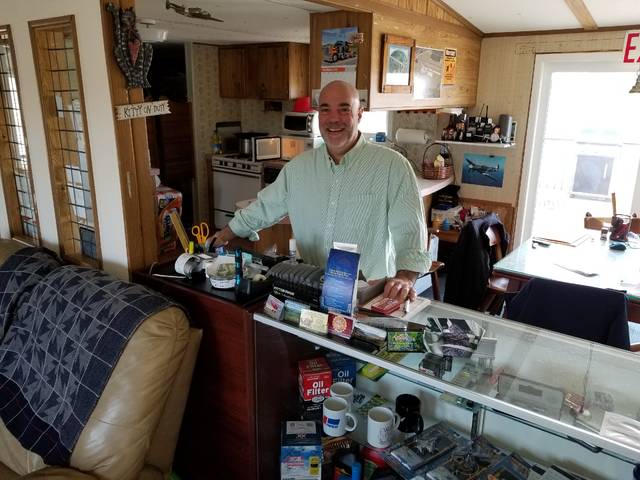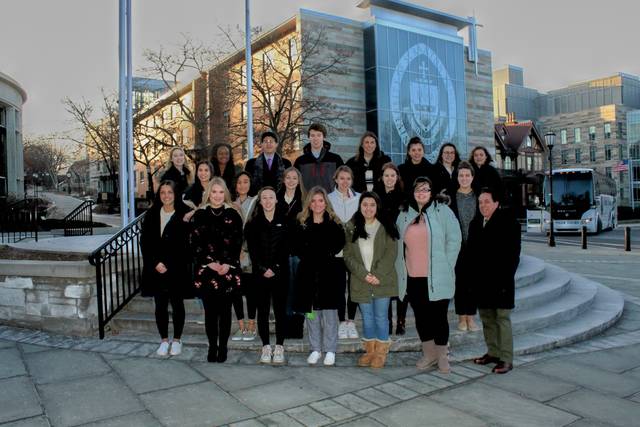FACTORYVILLE — Billy Dobitsch Jr., stood at the edge of the runway and looked to his left, down to where a large 4 had been applied to the asphalt in white paint. Then he looked to his right, toward the other end of the strip, which was marked with a white 22. No airplanes were visible in the sky. “We’re clear,” he said to a visitor before walking onto the runway.
It was a recent Saturday morning at Seamans Airport, and a biting wind was coming in from the west. Seamans is a public-use airport. Its runway lights are always on, matching its hours of operation. A number of private pilots base their airplanes at the facility.
“Relatively large aircraft can land here,” Dobitsch said. Most of the traffic is from single-engine airplanes, but certain twin-engine models also use the airport.
Once across the runway, Dobitsch began following a taxiway. Ahead was a house that had an airplane parked next to it. As Dobitsch walked, he marveled at how, next year, two decades will have passed since he first landed at Seamans Airport.
The airport is owned by one corporation, Skyline Holdings Inc., and operated by another, Endless Mountains Air Inc. Dobitsch serves as the president of both companies, which have the same five shareholders.
“I always wanted to learn to fly,” Dobitsch, 57, said later, sitting in the double-wide modular home that serves as the airport’s office, pilot shop and lounge.
In 1994, Dobitsch was living in Passaic County, NJ. Five days a week, he was crossing the Hudson River for a job with Morgan Stanley in Manhattan. The commute, and his duties, made his work days long.
After attending a local airshow, Dobitsch took flying lessons and obtained his private pilot’s license. He partnered with two other men to buy a small airplane. Flying whenever he could, he wished he could make his living from aviation.
In 1999, while looking through the classified ads in an aviation newspaper, Dobitsch saw a listing for an airport that was for sale in Pennsylvania.
“It didn’t even say what airport it was,” he recalled. “It just had a phone number.”
On a bright Sunday morning in the summer of 1999, Dobitsch flew 35 minutes from an airport in New Jersey and landed at Seamans Airport.
He liked what he found at the airport, with its 2,500-foot runway on 248 acres of land. The sellers, the children of the late airport founder Bob Seamans, wanted about $1 million for the real estate and improvements. Dobitsch was unable to obtain the financing.
He had told some of his Morgan Stanley colleagues about the airport, and the following year two of them joined Dobitsch’s effort to buy the place. This time, the financing was arranged and the group took over Seamans Airport in January 2001. Two additional shareholders were later added to the group.
“Part of our vision was to make a fly-in community,” Dobitsch said. “We had all this beautiful property. We wanted to do something on the other side of the runway, where people could have their airplane at their house.”
In 2005, development started on Skyline Estates. Engineering studies were done. Governmental approvals were obtained. Ground was broken for the construction of the first house in the summer of 2007. But the timing was poor.
The economic recession of 2008 caused severe turbulence to Seamans Airport and the general aviation industry.
“It hurt a big chunk of my business,” Dobitsch said. “Flying dropped off dramatically. It also hurt our business with the development, too.”
A number of people Dobitsch expected as neighbors never moved to Skyline Estates, never built homes and asked for their deposits to be returned. (Land plots are sold to the homeowners, who then get access rights to the runway.)
There is no control tower at Seamans Airport. Pilots use a dedicated radio frequency, 122.7 MHz, to announce their intentions.
“We’re not under positive air traffic control,” Dobitsch said. “So, it’s basically see and avoid.”
There is a 24-hour presence at the airport. Air Methods keeps a medivac helicopter inside a hangar on the property, and employs the chopper pilots. Commonwealth Health provides a nurse and an EMT. While working their shifts, the crew of three awaits emergency calls while inside a prefabricated building next to the airport offices.
Air Methods pays for the right to occupy space at Seamans Airport. Hangar leasing generates the largest segment of revenues for the airport. There are 34 T-hangars available.
“Basically, you pull your plane in front, push it back. It’s shaped like a T, like the shape of an airplane,” Dobitsch explained.
The largest hangar at the airport has been used sparingly since June 2016, when longtime tenant O & N Aircraft Modifications closed. Dobitsch blamed the cessation of business on a failure by the firm’s principals to have a transition plan for when they became older and wanted to retire. A FOR RENT sign has been applied to the window of the front door of the hangar, which is made of corrugated metal and painted sky blue.
“It was a great maintenance shop,” Dobitsch said. “They had a lot of very talented mechanics there.”
Commercial airports collect takeoff fees, which are determined by an aircraft’s weight.
“I don’t charge takeoff fees, normally,” Dobitsch said. “If anybody stays overnight, I’ll charge them a $10 a night fee.”
Many general aviation aircraft are fueled by gasoline. Seamans Airport sells 100-octane, low-lead aviation gasoline. The price was recently $4.85 a gallon. Pilots dispense their own fuel, using a pump activated by a credit card. Gasoline sales bring in additional revenues.
In a room at the back of the airport’s offices, Dobitsch has a shop where he sells oils, filters, lights and assorted expendables used in the operation of small aircraft.
Seamans Airport once had a flight school with a fleet of five aircraft. The airplanes were owned by the airport’s operating corporation, and rented to students and their instructors. By last summer, the fleet was down to one, when the aircraft was removed from service after a hard landing.
Dobitsch is looking to buy another airplane so flight lessons can resume. And he wants to soon pave Wright Way and Beacon Lane, the two roads in Skyline Estates. He hopes the development will move forward in a manner similar to 2007, before the economic recession. Two houses are now being constructed.
“We did have a number of very difficult years,” Dobitsch said. “We’ve passed that. And it looks like the real estate market has kind of turned around.”






